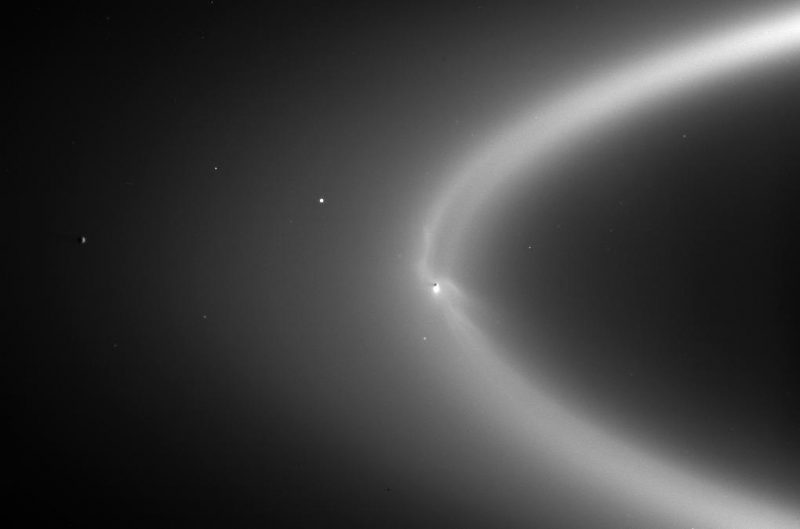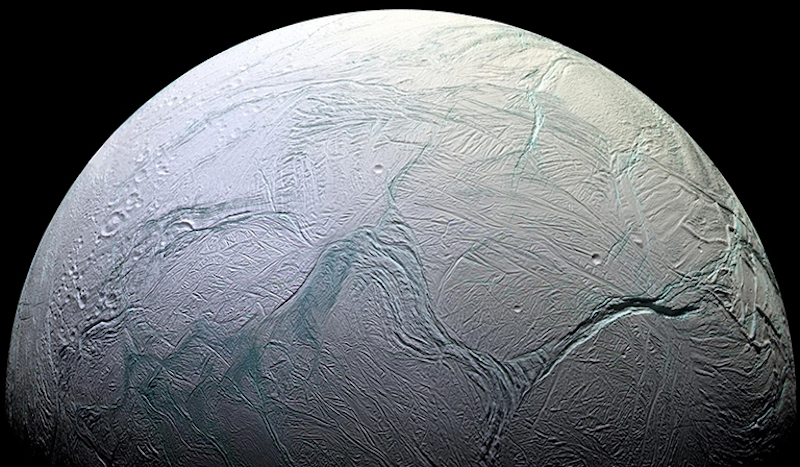
NASA/JPL published this original story on June 14, 2023. Edits by EarthSky.
Building block for life found on Enceladus
Using data collected by NASA’s Cassini mission, an international team of scientists has discovered phosphorus – an essential chemical element for life – locked inside salt-rich ice grains ejected into space from Enceladus.
The small moon is known to possess a subsurface ocean. Water from that ocean erupts through cracks in Enceladus’ icy crust as geysers at its south pole, creating a plume. The plume then feeds Saturn’s E ring (a faint ring outside of the brighter main rings) with icy particles.
During its mission at the gas giant from 2004 to 2017, Cassini flew through the plume and E ring numerous times. Scientists found that Enceladus’ ice grains contain a rich array of minerals and organic compounds – including the ingredients for amino acids – associated with life as we know it.

Phosphorous, a building block for life
Phosphorus is the least abundant of the essential elements necessary for biological processes. And scientists hadn’t detected it at Enceladus until now. The element is a building block for DNA, which forms chromosomes and carries genetic information. It’s present in the bones of mammals, cell membranes and ocean-dwelling plankton. Phosphorus is also a fundamental part of energy-carrying molecules present in all life on Earth. Life wouldn’t be possible without it.
Frank Postberg is a planetary scientist at Freie Universität Berlin, Germany, who led the new study. The peer-reviewed journal Nature published the study on Wednesday, June 14, 2023. Postberg said:
We previously found that Enceladus’ ocean is rich in a variety of organic compounds. But now, this new result reveals the clear chemical signature of substantial amounts of phosphorus salts inside icy particles ejected into space by the small moon’s plume. It’s the first time anyone has discovered this essential element in an ocean beyond Earth.
Previous analysis of Enceladus’ ice grains revealed concentrations of sodium, potassium, chlorine and carbonate-containing compounds. Computer modeling suggested the subsurface ocean is of moderate alkalinity. These are all factors that favor habitable conditions.

Analyzing the data
For this latest study, the authors accessed the data through NASA’s Planetary Data System. This system is a long-term archive of digital data products returned from the agency’s planetary missions. Planetary scientists actively manage the archive to ensure its usefulness and usability by the worldwide planetary science community.
The authors focused on data collected by Cassini’s Cosmic Dust Analyzer. This instrument sampled icy particles from Enceladus in Saturn’s E ring. Cassini analyzed many more ice particles when it flew through the E ring than when it went through just the plume. So the scientists were able to examine a much larger number of compositional signals there. By doing this, they discovered high concentrations of sodium phosphates – molecules of chemically bound sodium, oxygen, hydrogen, and phosphorus – inside some of those grains.

Experiments show a high concentration of phosphorus
Next, co-authors in Europe and Japan carried out laboratory experiments to show that Enceladus’ ocean has phosphorus. The phosphorous is bound inside different water-soluble forms of phosphate, in concentrations of at least 100 times that of our planet’s oceans. The team’s geochemical modeling demonstrated that an abundance of phosphate may also be possible in other icy ocean worlds in the outer solar system. In particular, those ocean worlds that formed from primordial ice containing carbon dioxide and where liquid water has easy access to rocks.
Co-investigator Christopher Glein, a planetary scientist and geochemist at Southwest Research Institute in San Antonio, Texas, said:
High phosphate concentrations are a result of interactions between carbonate-rich liquid water and rocky minerals on Enceladus’ ocean floor and may also occur on a number of other ocean worlds. This key ingredient could be abundant enough to potentially support life in Enceladus’ ocean; this is a stunning discovery for astrobiology.
No life found … yet
Although the science team is excited that Enceladus has the building blocks for life, Glein stressed that scientists have not found life on the moon. Or, for that matter, anywhere else in the solar system beyond Earth. He said:
Having the ingredients is necessary, but they may not be sufficient for an extraterrestrial environment to host life. Whether life could have originated in Enceladus’ ocean remains an open question.
Linda Spilker, Cassini’s project scientist at NASA’s Jet Propulsion Laboratory in Southern California, who was not involved in the study, said:
This latest discovery of phosphorus in Enceladus’ subsurface ocean has set the stage for what the habitability potential might be for the other icy ocean worlds throughout the solar system. Now that we know so many of the ingredients for life are out there, the question becomes: Is there life beyond Earth, perhaps in our own solar system? I feel that Cassini’s enduring legacy will inspire future missions that might, eventually, answer that very question.
Bottom line: Scientists have found phosphorus – a building block for life because it’s a key chemical element for many biological processes – in icy grains emitted by Saturn’s moon Enceladus. These scientists believe phosphorous is likely abundant in its subsurface ocean.
Source: Detection of phosphates originating from Enceladus’s ocean
The post Building block for life found on Saturn’s moon Enceladus first appeared on EarthSky.
0 Commentaires